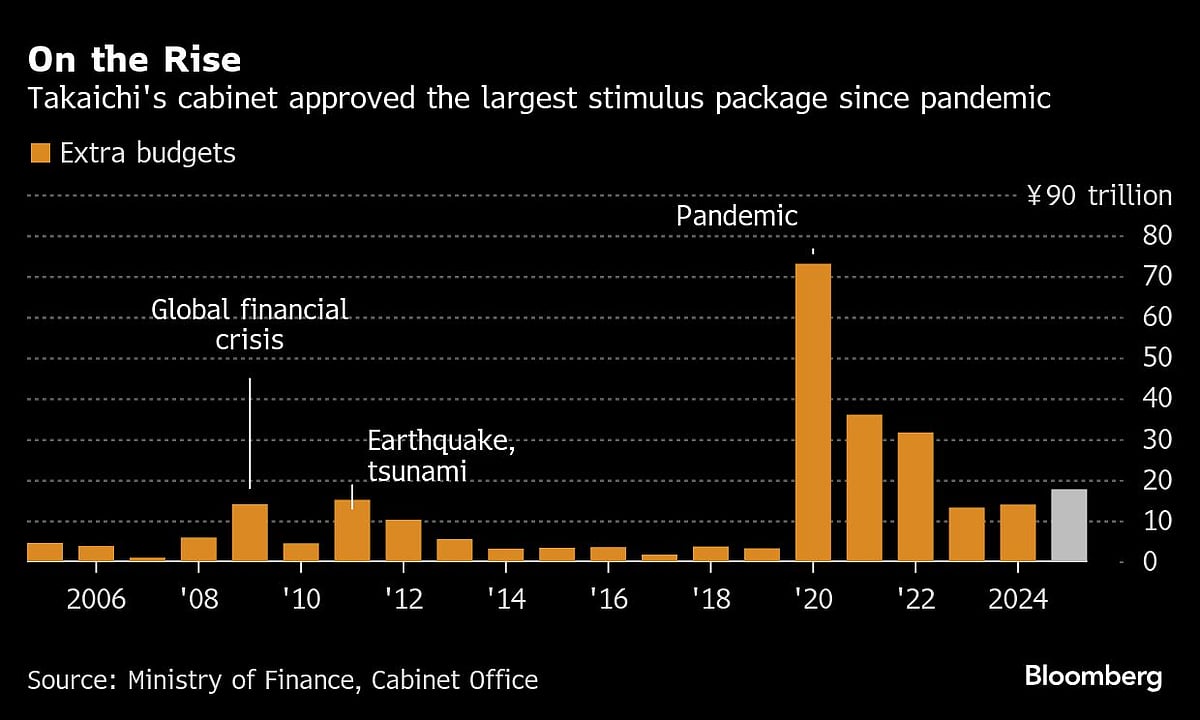Japan Approves $135 Billion Stimulus To Mitigate Inflation Pain
The stimulus plan includes ¥17.7 trillion ($112 billion) in general account spending, the Cabinet Office said Friday.

Japanese Prime Minister Sanae Takaichi’s cabinet approved the largest round of extra spending since the pandemic, deploying funds to address the frustrations of voters in a package that may unsettle investors scrutinizing the nation’s finances.
The stimulus plan includes ¥17.7 trillion ($112 billion) in general account spending, the Cabinet Office said Friday. Those outlays would likely be funded via an extra budget, and they mark a 27% jump over what her predecessor rolled out a year ago. The total package is valued at ¥21.3 trillion, with the bulk of the measures aimed at price relief.
“We’ve put together this package to protect livelihoods, and particularly to respond quickly to the problem of inflation,” Takaichi said after the details of the measures were released.

The biggest portion will go to price relief, totaling ¥11.7 trillion. That includes provisions to dole out ¥7,000 in subsidies for gas and electricity bills for each household over three months through March, a one-off ¥20,000 cash handout per child and ¥2 trillion in funds to aid regions.
“The initial amount they’d set aside was already large, but toward the end we could see the kind of process unique to a minority government, where they had to factor in opposition parties’ cooperation,” said Saori Tsuiki, senior economist at Mizuho Research & Technologies. “If the larger amount sends an unintended message to markets or overseas and ends up adding to yen-weakness risks, we may have to discount the expected economic impact of the package.”
The sizable allocation for price relief highlights Takaichi’s commitment to tackling persistent inflation, which has fueled voter frustration and contributed to the ouster of her predecessors. Data Friday showed that Japan’s key price gauge has stayed at or above the Bank of Japan’s 2% target for 43 straight months, marking the longest such stretch since 1992.
Among other measures to counter inflation, about ¥1 trillion was set aside to abolish the gasoline tax, a measure first proposed by opposition parties including the Liberal Democratic Party’s new junior coalition partner Ishin. Raising the income tax–free threshold, another idea originally from opposition parties, was also adopted, costing ¥1.2 trillion.
These price measures are together expected to push down the overall inflation gauge by an average 0.7 percentage point from February to April, according to the Cabinet Office.
The package also includes ¥1.7 trillion to strengthen defense and diplomatic capabilities, with ¥1.1 trillion allocated to help raise defense spending to 2% of gross domestic product this fiscal year after Takaichi moved the targeted timeline forward by two years. Another ¥7.2 trillion will be allocated for investment related to crisis management.
Takaichi earmarked ¥700 billion in reserve funds to address damage caused by natural disasters and incidents caused by bears.
Public support for Takaichi’s cabinet so far remains strong, according to local polls. An ANN survey conducted last weekend showed her approval rate rising 8.8 points to 67.5%, with a majority of respondents expressing hopes over her economic package.
Bond issuance will likely exceed last year’s levels, according to people with knowledge of the matter. Concerns over rising debt pushed yields on 5- and 10-year government bonds to their highest since 2008 earlier this week, while longer-dated yields climbed further. The yen weakened past 157 per dollar, its softest since January, prompting verbal warnings from senior officials.
“It is clear that Japan will face higher spending pressure on social security, interest payment and national defense for some time,” said Rain Yin, sovereign analyst at S&P Global Ratings. “However, our sovereign rating on Japan has already factored in Japan’s longstanding weakness in the fiscal balance and its extremely high government debt burden. This assessment is unlikely to worsen substantially from further weakening at the margin.”
Takaichi said that she expects total new bond issuance for this fiscal year to remain below last year’s level of ¥42.1 trillion. With the initial annual budget, Japan was set to issue an amount that was about 20% less than last year.
“We’ve given ample consideration to fiscal sustainability as well,” said Takaichi.
The government estimates that the package will lift the nation’s GDP by an average of about 1.4 percentage points per year on an annualized basis for three years assuming the measures take effect during that span, the government said. The economy posted its first contraction in six quarters in the July–September period partly due to the US tariff impact.
On that note, the economic package pledges to strengthen the financial foundations of the Japan Bank for International Cooperation and Nippon Export and Investment Insurance to ensure the implementation of a $550 billion investment fund that was a key part of Japan-US tariff agreement.
It also says it will explore new funding sources to invest in sectors critical to economic security, such as shipbuilding, quantum technology and critical minerals.

